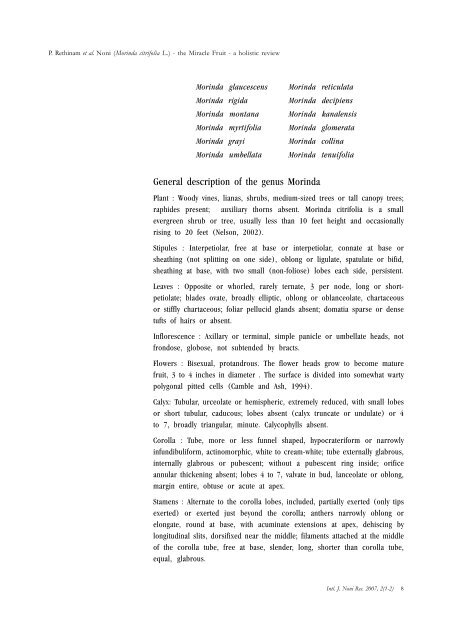International Journal of Noni Research - Noni Family
International Journal of Noni Research - Noni Family
International Journal of Noni Research - Noni Family
Create successful ePaper yourself
Turn your PDF publications into a flip-book with our unique Google optimized e-Paper software.
P. Rethinam et al. <strong>Noni</strong> (Morinda citrifolia L.) - the Miracle Fruit - a holistic review<br />
Morinda glaucescens Morinda reticulata<br />
Morinda rigida Morinda decipiens<br />
Morinda montana Morinda kanalensis<br />
Morinda myrtifolia Morinda glomerata<br />
Morinda grayi Morinda collina<br />
Morinda umbellata Morinda tenuifolia<br />
General description <strong>of</strong> the genus Morinda<br />
Plant : Woody vines, lianas, shrubs, medium-sized trees or tall canopy trees;<br />
raphides present; auxiliary thorns absent. Morinda citrifolia is a small<br />
evergreen shrub or tree, usually less than 10 feet height and occasionally<br />
rising to 20 feet (Nelson, 2002).<br />
Stipules : Interpetiolar, free at base or interpetiolar, connate at base or<br />
sheathing (not splitting on one side), oblong or ligulate, spatulate or bifid,<br />
sheathing at base, with two small (non-foliose) lobes each side, persistent.<br />
Leaves : Opposite or whorled, rarely ternate, 3 per node, long or shortpetiolate;<br />
blades ovate, broadly elliptic, oblong or oblanceolate, chartaceous<br />
or stiffly chartaceous; foliar pellucid glands absent; domatia sparse or dense<br />
tufts <strong>of</strong> hairs or absent.<br />
Inflorescence : Axillary or terminal, simple panicle or umbellate heads, not<br />
frondose, globose, not subtended by bracts.<br />
Flowers : Bisexual, protandrous. The flower heads grow to become mature<br />
fruit, 3 to 4 inches in diameter . The surface is divided into somewhat warty<br />
polygonal pitted cells (Camble and Ash, 1994).<br />
Calyx: Tubular, urceolate or hemispheric, extremely reduced, with small lobes<br />
or short tubular, caducous; lobes absent (calyx truncate or undulate) or 4<br />
to 7, broadly triangular, minute. Calycophylls absent.<br />
Corolla : Tube, more or less funnel shaped, hypocrateriform or narrowly<br />
infundibuliform, actinomorphic, white to cream-white; tube externally glabrous,<br />
internally glabrous or pubescent; without a pubescent ring inside; orifice<br />
annular thickening absent; lobes 4 to 7, valvate in bud, lanceolate or oblong,<br />
margin entire, obtuse or acute at apex.<br />
Stamens : Alternate to the corolla lobes, included, partially exerted (only tips<br />
exerted) or exerted just beyond the corolla; anthers narrowly oblong or<br />
elongate, round at base, with acuminate extensions at apex, dehiscing by<br />
longitudinal slits, dorsifixed near the middle; filaments attached at the middle<br />
<strong>of</strong> the corolla tube, free at base, slender, long, shorter than corolla tube,<br />
equal, glabrous.<br />
Intl. J. <strong>Noni</strong> Res. 2007, 2(1-2) 8








